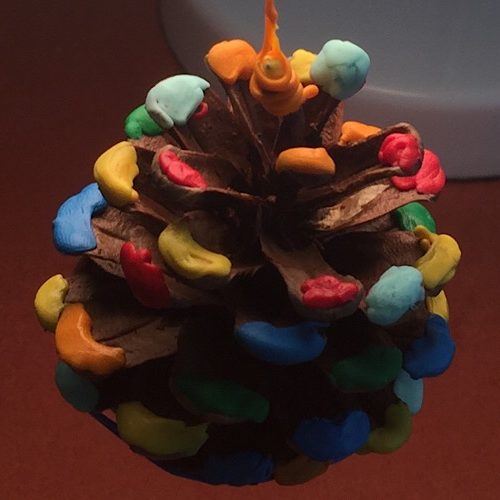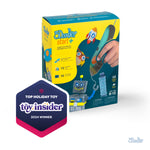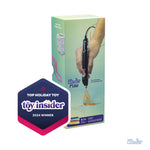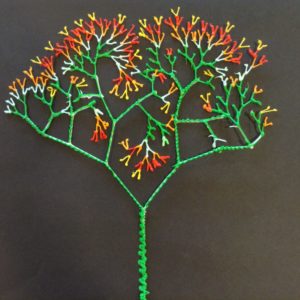MATH: Pine Cone Counting-Doodlers (Fractions: Comparing parts to whole)
Students will doodle pine cone scales with different colors, then work with the numerical significance of the scales in order to learn about fractions. Student will compare the number of scales in each specific color to the total number of scales in the form of a fraction.

KnowledgeStudents havepracticed identifying and writing fractions.
practiced using the 3Doodler.
practiced identifying and writing fractions.
practiced using the 3Doodler.
ObjectivesStudents willuse a 3Doodler to doodle the tips of a pine cone using 6 colors.
count the number of scales doodled in each color on their pine cone.
count the total number of scales on their pine cone.
express each color's numerical significance as compared to the total number of scales in the form of a fraction.
fill in the Pine Cone Data Sheet with the correct numbers and fractions.
use a 3Doodler to doodle the tips of a pine cone using 6 colors.
count the number of scales doodled in each color on their pine cone.
count the total number of scales on their pine cone.
express each color's numerical significance as compared to the total number of scales in the form of a fraction.
fill in the Pine Cone Data Sheet with the correct numbers and fractions.
MaterialsStudents will need3Doodler Start (1 per pair)
Pencil (1 per student)
Pine Cone (1 per student)
Pine Cone Data Sheet (1 per pair)
3Doodler Start (1 per pair)
Pencil (1 per student)
Pine Cone (1 per student)
Pine Cone Data Sheet (1 per pair)
Lesson PlanInstructions
Step 1 - PREPARATIONTake students on a nature walk to collect pine cones or have students bring in pine cones from home. Be sure inform students to find opened pine cones.
Step 2Call students to the whole group: Project your tablet or screen on the board for students to view the Pine Cone Data Sheet. Note the scales on the pinecone. Count them with the students. Enter the total on the Pine Cone Data Sheet. *Note that the word “data” means information.
Step 3Share the goal: Today we will doodle pine cone scales with different colors, then work with the numerical significance of the scales in order to learn about fractions. We will compare the number of scales in each specific color to the total number of scales in the form of a fraction.
Step 4Ensure students have their pine cones ready. Have each student in a pair count the total number of scales on their individual pine cones, and then get the students to compare their totals. Recount if they are different. Hand out one Pine Cone Data Sheet to each student and pencils for each pair to record their total of pine cone scales.
Step 5Model how to use 6 colors to doodle each tip on your pine cone. You may work in a pattern, or doodle intermittent scales. Doodle the scale's tip in one spot, holding your 3Doodler steady for about 3 seconds. Then press the warm plastic down onto the scale with your finger to form a smooth cover.
*See reference images.
Step 6Instruct students how to fill in the names of the colors used on the Pine Cone Data Sheet and fill in the total number of scales doodled in each color. Then instruct students how to record the number of each color as the numerator (top number) and the total of scales as the denominator (bottom number) for their fractions.
Step 7Hand out the 3Doodlers and the Pine Cone Data Sheets for students. Circle to assist and assess as students work.
Step 8Have the students in the pairs compare the data in their pinecones and worksheets.
Take students on a nature walk to collect pine cones or have students bring in pine cones from home. Be sure inform students to find opened pine cones.
Call students to the whole group: Project your tablet or screen on the board for students to view the Pine Cone Data Sheet. Note the scales on the pinecone. Count them with the students. Enter the total on the Pine Cone Data Sheet. *Note that the word “data” means information.
Share the goal: Today we will doodle pine cone scales with different colors, then work with the numerical significance of the scales in order to learn about fractions. We will compare the number of scales in each specific color to the total number of scales in the form of a fraction.
Ensure students have their pine cones ready. Have each student in a pair count the total number of scales on their individual pine cones, and then get the students to compare their totals. Recount if they are different. Hand out one Pine Cone Data Sheet to each student and pencils for each pair to record their total of pine cone scales.
Model how to use 6 colors to doodle each tip on your pine cone. You may work in a pattern, or doodle intermittent scales. Doodle the scale's tip in one spot, holding your 3Doodler steady for about 3 seconds. Then press the warm plastic down onto the scale with your finger to form a smooth cover.
*See reference images.
Instruct students how to fill in the names of the colors used on the Pine Cone Data Sheet and fill in the total number of scales doodled in each color. Then instruct students how to record the number of each color as the numerator (top number) and the total of scales as the denominator (bottom number) for their fractions.
Hand out the 3Doodlers and the Pine Cone Data Sheets for students. Circle to assist and assess as students work.
Have the students in the pairs compare the data in their pinecones and worksheets.
Wrap Up
Assessment
Possible Extensions
Vocabulary
collaboration - to work jointly with others or together especially in an intellectual endeavor.
color - the quality of an object or substance with respect to light reflected by the object, usually determined visually by measurement of hue, saturation, and brightness of the reflected light; saturation or chroma; hue.
comparing - to examine the character or qualities of especially in order to discover resemblances or differences.
counting - to indicate or name by units or groups so as to find the total number of units involved.
creativity - the quality of having or showing an ability to make new things or think of new ideas.
fraction - a number usually expressed in the form a/b.
nature - the physical world and everything in it (such as plants, animals, mountains, oceans, stars, etc.) that is not made by people.
pattern - an artistic, musical, literary, or mechanical design or form.
percentage - a rate or proportion per hundred.
problem-solving - the process or act of finding a solution to a problem.
ratio - the relationship in quantity, amount, or size between two or more things.
spirals - a plane curve generated by a point moving around a fixed point while constantly receding from or approaching it.
whole number - A whole number is a number without a fractional or decimal part, and with no negative values (i.e., 1, 2, 3...500, 501, etc.).
Educational Standards
Understand a fraction 1/b as the quantity formed by 1 part when a whole is partitioned into b equal parts; understand a fraction a/b as the quantity formed by a parts of size 1/b.
Students will compare the parts (doodled scales) to the whole (the total number of pine cone scales).
Explain equivalence of fractions in special cases, and compare fractions by reasoning about their size.
Students will record the number of scales in each color and compare them to the total number of scales as a fraction, and then compare fractions for size.
Decompose (break down) a larger problem into smaller sub-problems with teacher guidance or independently.
Students will break down the process of recording the part to the whole as a fraction through a process of doodling, observing, recording, and sharing data.
Use technology to seek feedback that informs and improves their practice and to demonstrate their learning in a variety of ways.
Students will use the 3Doodler to doodle the scales on a pine cone in order to practice recording the part to the whole as a fraction, and comparing fractions.
Exhibit a tolerance for ambiguity, perseverance and the capacity to work with open-ended problems.
Students will demonstrate willingness and competency within an open-ended task with more than one possible outcome.
Create original works or responsibly repurpose or remix digital resources into new creations.
Students will create original doodled pine cones according to their own designs.
Use collaborative technologies to work with others, including peers, experts or community members, to examine issues and problems from multiple viewpoints.
Students will seek feedback from peers throughout the design, counting and discussion phases of this project.





